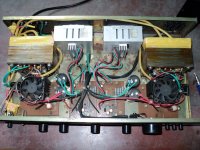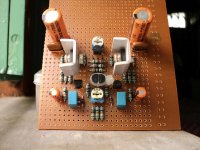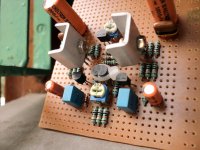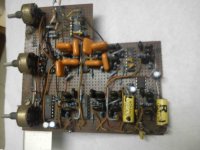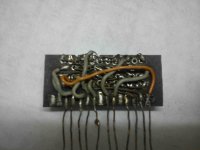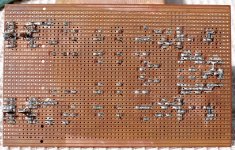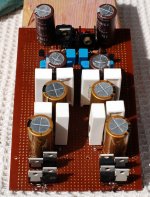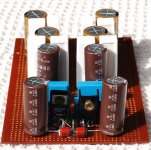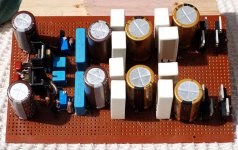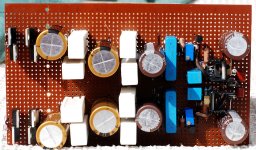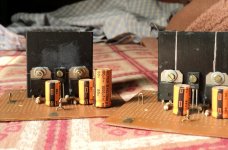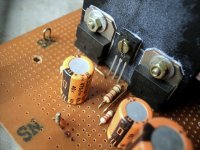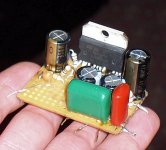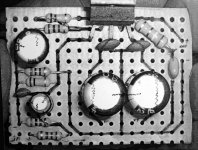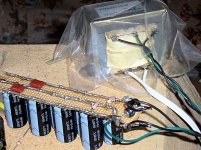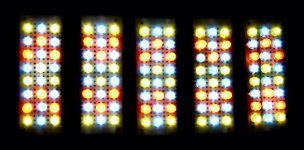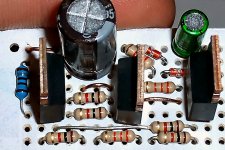Nice board, but what is it?
Sorry, I forgot to mention, its my first cmoy build using different power.
Shaan, your vero board builds are truly "benishaan" (Urdu/Persian for
flawless)! Very inspiring to see what can be achieved on vero boards.
Like Salas said on the SSA thread, your SSA build below is a sheer work of art.
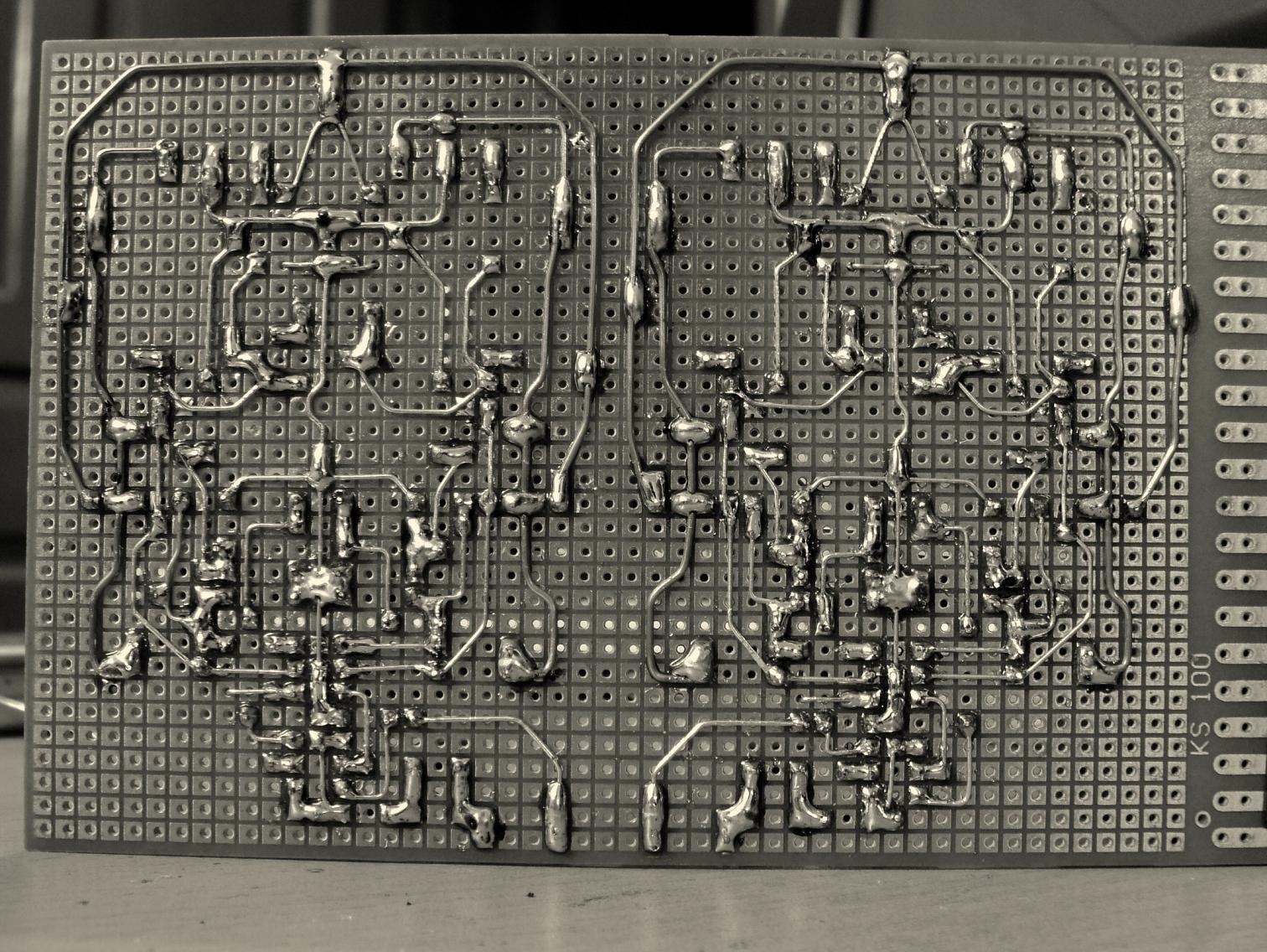
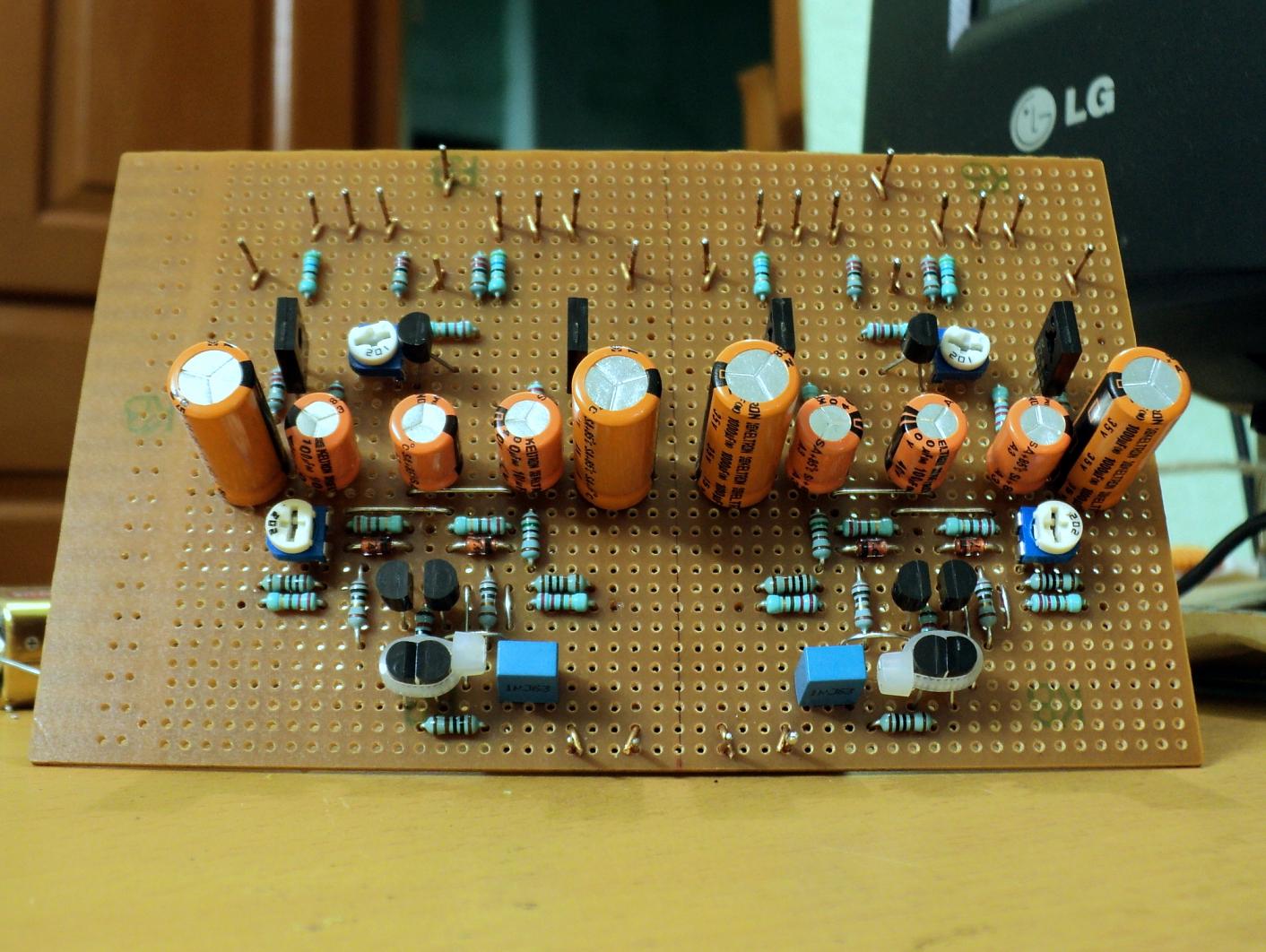
Thanks quadtech. I completely forgot to post it here since I have some difficulties with the SSA(first time symmetrical design, so I expected this). I still love building amplifiers on veroboards. SSA itself is such a beautiful design that one just has to place the parts where they are supposed to be, and it starts to looks elegant. Special thanks to LC.
Quadtech, here is my opamp type SSA which I call SSOPA! Made only one channel out of curiousity. Worked(and working) without any problem so far.  I may soon start a new thread on it as the sound signature is identical to SSA. Speciality: No electrolytics anywhere in the signal path.
I may soon start a new thread on it as the sound signature is identical to SSA. Speciality: No electrolytics anywhere in the signal path.
Attachments
Last edited:
OK here is my latest. My YARPS dual rail power supply, +/- 10V using LT317A's only (ie no negative reg). Finally it has seen the light of day  Note this was an exercise in overkill
Note this was an exercise in overkill 
Tony.

Tony.
Attachments
Last edited:
Somehow I missed this thread earlier. I'll see if I can find some boards I made years (okay, decades) ago and post pics, featuring, among other things, the SAD1024. I'll bet that part number brings back memories for someone.
Tubelab's stories remind me of similar projects I did. I recall getting a Paia Electronics catalog circa 1975 from an ad in Popular Electronics. I didn't order any parts, but I did get their little magazine on making synthesizers that was just starting that they named Polyphony. I think the first issue was "2/76," my first year in college (that same year I stopped in the Heathkit retail store and bought a rather expensive, $5 or so, magazine that described making your own Heil AMT tweeter, named Audio Amateur). Over the years it became more of a "real" magazine and and a separate production from Paia, and then was renamed Electronic Musician, and last I saw was still going.
I made a few crude synthesizers with limited funds and knowledge, using 555's as oscillators and such. I recall making a voltage-controlled filter using a twin-tee RC network in the feedback path of an opamp, and using a forward-biased diode replacing the resistor to ground. The more current into the diode, the lower its dynamic resistance and the higher the resonant frequency. That may have been a circuit I saw in Polyphony/Electronic Musician, but that was the cheapness level of the circuits I could make, as I had way too little money in college.
In the early '80's I made a synth prototype using the 6850 "SID" chip from Commodore that was used in the Commodore 64 computer. There was a few pages in Polyphony (or was it Electronic Musician by then?) that described (essentially printed the data sheet for) the then-new chip. I called around and found out that Commodore had decided NOT to sell the chip on the open market, and only use it in their computers. I did get two chips from a Commodore service center, and made a processor-controlled musical keyboard scanner and code to run the chip, and got three-voice polyphony from one chip, though all three oscillators went through the same filter. I wanted to have five chips so I could have five voices, each one with three oscillators and its own filter, but with no source of (reasonably priced) chips, it was not to be.
Later in the '80's I saw that the latest polysynths used the newfangled all-in-one analog chips that did a whole module function on one chip with just adding resistors and capacitors - whole temperature-compensated VCOs and VCFs! These were made by apparently new startups CEM and SSM. Whatever many thousands of chips a year they sold apparently wasn't a large enough market to stay in business, so both companies went out of business. Someone (Analog Devices?) bought SSM, but only continued the most commonly used chips, a mic preamp and VCA, which were in use in many other (and more popular) products than synthesizers, and which were already made by other companies. And so they join the SAD1024 as a neat idea that apparently at some point didn't meet the many-millions-of-units-per-year sales needed for viable semiconductor products.
Tubelab's stories remind me of similar projects I did. I recall getting a Paia Electronics catalog circa 1975 from an ad in Popular Electronics. I didn't order any parts, but I did get their little magazine on making synthesizers that was just starting that they named Polyphony. I think the first issue was "2/76," my first year in college (that same year I stopped in the Heathkit retail store and bought a rather expensive, $5 or so, magazine that described making your own Heil AMT tweeter, named Audio Amateur). Over the years it became more of a "real" magazine and and a separate production from Paia, and then was renamed Electronic Musician, and last I saw was still going.
I made a few crude synthesizers with limited funds and knowledge, using 555's as oscillators and such. I recall making a voltage-controlled filter using a twin-tee RC network in the feedback path of an opamp, and using a forward-biased diode replacing the resistor to ground. The more current into the diode, the lower its dynamic resistance and the higher the resonant frequency. That may have been a circuit I saw in Polyphony/Electronic Musician, but that was the cheapness level of the circuits I could make, as I had way too little money in college.
In the early '80's I made a synth prototype using the 6850 "SID" chip from Commodore that was used in the Commodore 64 computer. There was a few pages in Polyphony (or was it Electronic Musician by then?) that described (essentially printed the data sheet for) the then-new chip. I called around and found out that Commodore had decided NOT to sell the chip on the open market, and only use it in their computers. I did get two chips from a Commodore service center, and made a processor-controlled musical keyboard scanner and code to run the chip, and got three-voice polyphony from one chip, though all three oscillators went through the same filter. I wanted to have five chips so I could have five voices, each one with three oscillators and its own filter, but with no source of (reasonably priced) chips, it was not to be.
Later in the '80's I saw that the latest polysynths used the newfangled all-in-one analog chips that did a whole module function on one chip with just adding resistors and capacitors - whole temperature-compensated VCOs and VCFs! These were made by apparently new startups CEM and SSM. Whatever many thousands of chips a year they sold apparently wasn't a large enough market to stay in business, so both companies went out of business. Someone (Analog Devices?) bought SSM, but only continued the most commonly used chips, a mic preamp and VCA, which were in use in many other (and more popular) products than synthesizers, and which were already made by other companies. And so they join the SAD1024 as a neat idea that apparently at some point didn't meet the many-millions-of-units-per-year sales needed for viable semiconductor products.
These are my two +ve voltage capacitance multipliers built for a pair of class-a amplifiers. They can provide maximum 4A current with virtually no ripple voltage. These are the simplest circuits I built on vero, but they work like a charm!
Attachments
OK here is my latest. My YARPS dual rail power supply, +/- 10V using LT317A's only (ie no negative reg). Finally it has seen the light of dayNote this was an exercise in overkill

Tony.
Nice work!! its funny, perfboard creations lend themselves really well to overkill, I guess because you arent limited by any positions on the PCB. I also tend to go crazy with parallel, but lately my opinion has changed on its effectiveness
I actually found something without having to look around too much. Unfortunately it's all digital except for the big LAS1405 3-amp (I just looked it up) regulator. But it's at least music-related. It's from circa 1989. It was going to be a MIDI merger and do-all box. I don't remember if I actually sent MIDI through it, but it has a couple of serial chips, and what's not with this is a 16x2 LCD display. I did at least have code to display things on it, and the LED on each of the 5 buttons at the top would light when you press it (and turn off any other light), and display a menu for that button.
The 40-pin chip on the left is a 6502. About the only other thing of note is there's a little 5k trimpot in the middle of the board, and I can't remember for the life of me why it's there. There's certainly no A/D converter on the board.
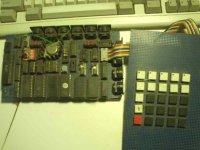
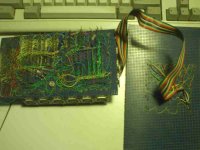
The 40-pin chip on the left is a 6502. About the only other thing of note is there's a little 5k trimpot in the middle of the board, and I can't remember for the life of me why it's there. There's certainly no A/D converter on the board.


The only thing more fun than the copperless phenolic perfboard is omitting it for a tangle with point to point.  Anyway, here's the perfboard stuff. Of course if you get bored with tan color, you could try Krylon.
Anyway, here's the perfboard stuff. Of course if you get bored with tan color, you could try Krylon.  That's kind of pretty and doesn't have that phenolic board smell. A bunch of mine is painted white for the LED lighting projects.
That's kind of pretty and doesn't have that phenolic board smell. A bunch of mine is painted white for the LED lighting projects.
In order from left to right, they are:
TDA7294 (normal version except for capdiv power), LM1875 turbo (minimized feedback for maximized dynamics), low inductance PSU (nicely clean but requires a bigger transformer), broad bandwidth LED lighting (solar powered fake sunshine), and Ken Peter's phase inverter bridging adapter (my amp has output devices smaller than the phase inverter. lol!). These are the photos that I can find at the moment, but there are more.
In order from left to right, they are:
TDA7294 (normal version except for capdiv power), LM1875 turbo (minimized feedback for maximized dynamics), low inductance PSU (nicely clean but requires a bigger transformer), broad bandwidth LED lighting (solar powered fake sunshine), and Ken Peter's phase inverter bridging adapter (my amp has output devices smaller than the phase inverter. lol!). These are the photos that I can find at the moment, but there are more.
Attachments
And now it hits me, the trimpot is for the LCD module contrast adjustment.
Hehe that was some serious hacking benb!!!
- Home
- General Interest
- Everything Else
- Post Pictures of Your Vero Board Designs Here.

